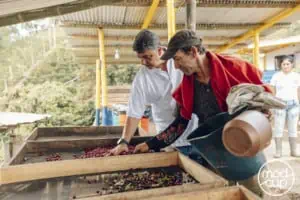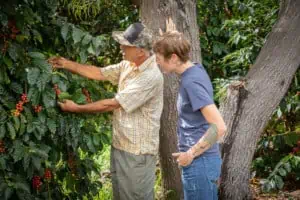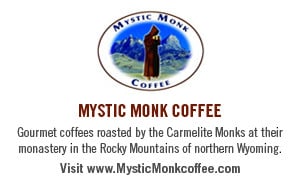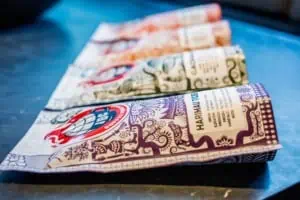Coffee Review’s list of the Top 30 Coffees of 2019 represents our seventh annual ranking of the most exciting coffees we tested over the course of the year. This annual effort supports our mission of helping consumers identify and purchase superior quality coffees and, in the process, helping drive demand and increase prices to reward farmers and roasters who invest time, passion and capital in producing high-quality coffee. The Top 30 celebrates and promotes coffee roasters, farmers, mill operators, importers, and other coffee industry professionals who make an extra effort to produce coffees that are not only superb in quality but also distinctive in character.

Rigoberto Herrera (background), co-owner of the Cafe Granja la Esperanza farm in Colombia, grower of No. 12 modcup coffee. Courtesy of Jefferson Jimenez, modcup.
In 2019, we tasted more than 1,300 coffee samples and published more than 300 reviews. The reviews focused primarily on the highest-rated coffees, which are of most interest to our readers. This year, around 23% of the more than 1,300 coffees we tested scored 90 points or higher, and over 100 of them, an impressive 8% of the total, rated 94 or higher, a tribute to the ever-intensifying innovation and dedication of the world’s leading coffee producers and roasters.
However, it is important to remind our frequent readers, that the coffees that appear in the reviews on our website represent the tip of the iceberg in terms of distinction and quality. Remember that we cup blind; we determine ratings and main descriptors for a coffee before we learn where it came from and who roasted it. For those curious about how we conduct our testing and rating processes at Coffee Review, see How Coffee Review Works. For what scores mean in respect to the wide range of coffee styles and qualities, see Interpreting Reviews.
However, despite our efforts to make our ratings consistent and meaningful, numbers taken alone have limitations. You may well like a lower-rated coffee that matches your taste preferences more than a higher-scoring coffee that isn’t your style. We do our best to characterize a coffee’s character in the “Blind Assessment” paragraph of our reviews and even more succinctly in the “Bottom Line” paragraph that concludes each review.
Hard Choices: Narrowing Down the List

Amavida Coffee’s Martin Trejo, roaster of No. 21 Espresso Mandarina. Courtesy Aleighsa Wright, Wright Media PC.
All of the coffees that rated 94 points or higher in 2019 are worthy of celebrating, as are the exceptional coffees that hovered just behind them in rating. Obviously, not all of the more than 100 coffees earning 94 points or more in 2019 can appear in the Top 30. We forced ourselves to select the 30 we felt were the most exciting and the most worthy of recognition.
As in past years, we selected and ranked our Top 30 coffees and espressos based on quality (represented by overall rating), value (reflected by most affordable price per pound), and consideration of other factors that include distinctiveness of style, uniqueness of origin or tree variety, certifications such as Fair Trade and organic, and general rarity.
Top 30 Statistics
Average Ratings. The average overall rating of the coffees on the Top 30 list for 2019 was 95.0 out of a possible 100, generally in line with past averages of 94.6 in 2018, 94.9 in 2017, 95.0 in 2016, and 94.8 in 2015.
Cost per Pound: From Very (Very) High to Reasonable. One can’t directly compare the price of Top 30 coffees from year to year because the mix of coffees varies dramatically.

Tamas Christman and Wilford Lamastus receive Best of Panama award. Courtesy of Specialty Coffee Association of Panama.
In 2019, the outlier in regard to price was the Elida Estate Geisha Green-Tip Natural from Dragonfly Coffee Roasters, the No. 1 Coffee of 2019. Not only was it the first coffee in Coffee Review’s 22-year history to earn 98 points (see At Long Last, A 98-Point Coffee), this coffee also took first place in the 2019 Best of Panama green coffee competition and subsequently was auctioned for the then highest price ever paid for a green coffee: US$1029 per pound. For the handful of high-rolling enthusiasts who had the chance to taste this exceptional coffee, Dragonfly Coffee charged an equally exceptional $100.00 per 21-gram sample, or a whopping $2,187 per pound, for its 98-rated version. The Dragonfly version is sold out, but those who remain interested in sampling this record-breaking coffee still can. As we publish this report, two roasters, Willoughby’s Coffee & Tea and Klatch Coffee, are offering their versions of the same green coffee for sale. We rated both the Willoughby’s and the Klatch versions at 97, only one point behind the Dragonfly. We chose not to place either the Willoughby’s or the Klatch versions in our Top 30, however, to avoid dominating the list with three versions of the same green coffee.
Excluding average-busting 98-point Dragonfly Elida Geisha, the average price of the remaining 29 coffees on the 2019 list was a record-setting $71.77 per pound. The previous record was an average price of $53.11 per pound in 2017. The very high average price of 2019 was skewed higher by four coffees that were priced at more than $100 per pound, a fifth coffee that cost over $200 per pound, and a sixth that cost over $300 per pound.
As in past years, higher scoring coffees in our 2019 Top 30 tended to cost more:
| 98-point coffee (1) | $2,176.87/pound |
| 96- and 97-point coffees (11) | $122.18/pound |
| 95-point coffees (8) | $48.74/pound |
| <=94-point coffees (10) | $34.75/pound |
However, one of the selection criteria for the Top 30 coffees is value, measured by price per pound relative to coffees of similar quality. Many of the coffees on our list are priced in line with similar, though usually less distinguished, specialty coffees in the marketplace. One third (10) of the coffees on the list cost $25 or less per pound. Three were priced at $20 or less per pound, namely: No. 25 Kakalove Café (Taiwan), El Salvador Cerro Las Ranas Honey Espresso (94 points; US $11.76/16 ounces); No. 27 Paradise Roasters, Moonbow Decaf (92 points; $14.95/12 ounces), and No. 29 Jackrabbit Java, Rwanda Nyarusiza Station (93 points; $12.00/12 ounces). See our complete list of the Best Value Coffees of 2019.
Origins of the Top 30 Coffees
In each of the seven years that we have published our Top 30 list, our top pick has been a single-origin coffee — meaning a coffee from a single country and region (and usually from a single farm or cooperative). Previous No. 1 coffees were produced in Hawaii (2018), Yemen (2017), Kenya (2016), Panama (2014 and 2015) and Ethiopia (2013).
With six appearances in the Top 30, Panama was the most frequently appearing origin in 2019, primarily due to the presence of five outstanding coffees of the Geisha variety, including the top, 98-rated Dragonfly Elida Estate Natural discussed earlier. Geisha has become a specialty of Panama producers in the years since 2004, when the Price Peterson family rediscovered this startling-tasting Ethiopian variety on their Hacienda Esmeralda farm in 2004. Colombia was second with four coffees, including one Geisha. Origins with two coffees each on the list include Costa Rica, Ethiopia, Hawaii, Kenya, and Sumatra.
Roasters in the Top 30
Six roasting companies placed two coffees each on this year’s Top-30 list: Dragonfly Coffee Roasters (No. 1 and 6); JBC Coffee Roasters (No. 2 and 7); Bird Rock Coffee Roasters (11 and 15); Klatch Coffee Roasting (17 and 24); Paradise Roasters (18 and 27); Kakalove Café, Taiwan (20 and 25). This concentration of coffees from certain roasters is certainly not by design. We make a conscious effort to increase the number and variety of roasters that appear in the Top 30.
In fact, this year we consciously limited appearances in the Top 30 to a maximum of two coffees per roaster, regardless of how many high-rated coffees that roaster produced. While that may seem like an arbitrary limit – and it is – it’s important to remember that our list represents our rendering of the most “exciting” coffees of the year, not necessarily the highest-rated. We felt that it wouldn’t be very exciting (to us or others) if the Top 30 list were too much dominated by roasting companies that produced a particularly large number of highly rated coffees over the course of the year. Instead, we felt readers might be more excited about an amazing coffee from a roaster that wasn’t already on the list, rather than a similarly incredible coffee from a roaster that already had two on the list.
That said, Coffee Review has been, from its inception, committed to starting with what we actually experience in the cup, not with product categories or marketing considerations or fashion. It is true that we take into account extrinsic factors like value, rarity and sustainable intentions into account when we narrow the number of candidates from over 100 to 30, but ultimately, sensory quality and distinction in the cup, as determined by blind-tasting and as reflected in rating, is the entry point for consideration and one of the primary factors that influences where coffees land on the list.
Roaster Geography
Of the 30 coffees on the list, 23 were roasted by companies in the United States, and four were roasted in Taiwan. Roasters from Australia, China and Hong Kong also placed one coffee each in the Top 30. Roasters from 14 U.S. states are represented — California roasters lead the rankings, with five representatives overall. Three were roasted in Hawaii.
Tree Variety and the Top 30

Origin Coffee’s Heather Brisson-Lutz with Gerry Ross at Kupa’a Farms, responsible for No. 16 Maui Kupa’a Orange Bourbon. Courtesy of Origin Coffee.
With well over half of the Top 30 coffees, distinctive tree variety appears to play an important role in generating an exceptional cup worthy of a high rating. There are stars and superstars among the hundreds of varieties of Arabica grown in the world today, and coffees from these distinguished varieties frequently dominate the very highest ratings at Coffee Review, whether we want them to or not. They include the still-rare and expensive Geisha/Gesha variety (eight examples on the 2019 list); the ancient heirloom Bourbon (five), and the great SL28 and SL34 varieties of Kenya (three). Also on the list: Mocca, Sudan Rume, Bourbon Pointu, Bourbon Rey, Parainema, Caturra, and Catuai.
Processing Method and the Top 30

Front gate at Ninety Plus Geisha Estates, producer of No. 10 Panama Perci Geisha Natural by Willoughby’s Coffee & Tea. Courtesy of Barry Levine.
Processing method (how the skin and fruit flesh are removed from the beans and how they are dried) also appeared to play a significant role in qualifying for the Top 30. On this year’s list, for example, of the 25 coffees for which processing method is clearly identified, eleven (vs. seven in 2018 and six in 2017) were produced by some form of dry or “natural” processing, meaning the beans were dried inside the fruit rather than after the fruit has been removed, as is the case with wet-processed or “washed” coffees. Until the last 10 years or so, dry-processing was seldom applied to high-end specialty coffees like those that appear on our Top 30 list. This showing is evidence of the continuing trend toward use of alternative processing methods as creative tools for crafting distinctive cup profiles.
Please enjoy our list of the Top 30 Coffees of 2019.
All the best from Coffee Review for a happy and prosperous new year, full of both coffee surprises and the reassurance of the fine and familiar.












